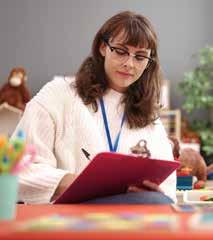







co-regulation - II ll BLOOMSBURY
Kerry Murphy fantastic ideas for
BLOOMSBURY, BLOOMSBURY EDUCATION and the Diana logo are trademarks of Bloomsbury Publishing Plc
First published in Great Britain, 2024 by Bloomsbury Publishing Plc
This edition published in Great Britain, 2024 by Bloomsbury Publishing Plc
copyright © Kerry Murphy, 2024 Photographs © Kerry Murphy, 2024 and Shutterstock, 2024
Kerry Murphy has asserted her rights under the Copyright, Designs and Patents Act, 1988, to be identified as Author of this work
Bloomsbury Publishing Plc does not have any control over, or responsibility for, any third-party websites referred to or in this book. All internet addresses given in this book were correct at the time of going to press. The author and publisher regret any inconvenience caused if addresses have changed or sites have ceased to exist, but can accept no responsibility for any such changes
All rights reserved. No part of this publication may be reproduced or transmitted in any form or by any means, electronic or mechanical, including photocopying, recording, or any information storage or retrieval system, without prior permission in writing from the publishers
A catalogue record for this book is available from the British Library
ISBN: PB: 978-1-8019-9280-0; ePDF: 978-1-8019-9281-7
Text design by Laura Neate
Printed and bound in India by Replika Press Pvt. Ltd

To find out more about our authors and books visit www.bloomsbury.com and sign up for our newsletters
Introduction 4 Adult self-regulation Bottom-up or top-down? ............................ 6 Stress blueprint 7 Wellbeing blueprint ...................................... 8 Mood meter 9 Self-regulation scripts 10 Co-regulating spaces ................................ 12 Co-regulation check-ins 13 Code word ................................................. 14 Teaching through co-regulation Body mapping ........................................... 15 Siegel’s hand 16 The angry iceberg 18 The fizzy pop analogy ................................ 20 Kintsugi 21 The guard dog and the wise owl ............... 22 Lions, falcons and sloths… oh my! ........... 23 Stressors and sensations Breathing buddies ..................................... 24 Power on/power off 25 Jumping for joy .......................................... 26 Breathing basket 28 Breathing monsters 29 Homemade stress balls ............................. 30 Regulating up 31 Regulating down ....................................... 32 Connecting Holding you in mind 33 Full of feelings jar ...................................... 34 Box of bear hugs 36 Strength building Jar of strengths ......................................... 37 Positivity paperchain ................................. 38 Behaviour RULER 39 Whole-body communication ...................... 40 Visual choice board ................................... 41 Active co-regulation Sniffing boxes 42 Self-regulation stories ............................... 44 Stretch it out .............................................. 45 Story drawing 46 Feelings den 47 Nature bathing ........................................... 48 Me-time bag .............................................. 50 ‘I Feel, I Can’ chart 51 Sensory spa 52 Self-advocacy Creating consent 54 ‘Save it’ table 55 Jigsaw journey 56 Positivity plant ........................................... 57 Transitions Transition cards 58 Bubble messages ...................................... 59 Transition tours .......................................... 60 Connectors 61 The pick-up chart 62 Transition bag 63 References and Glossary References 64 Contents BLOOMSBURY EDUCATION Bloomsbury Publishing Plc 50 Bedford Square, London, WC1B 3DP, UK 29 Earlsfort Terrace, Dublin 2, Ireland
Text
6
10 9 7 5 3 1
2 4
8
Introduction
Much of our time as early educators is spent engaged in caregiving. The rituals of supporting children’s sleeping, eating and personal care are the earliest acts of dignity we can provide. In this caring role, we are also supporting something much less visible yet equally important: the child’s developing nervous system and mind. In a child’s earliest years, we soothe, serve, repair, replenish, nurture and hold in mind their emotional and social development and their increasing capacity to eventually manage their own bodies, minds and behaviours, often referred to as self-regulation.
Self-regulation refers to a child’s ability to manage their emotions, thoughts and behaviours. It involves consciously regulating one’s own internal and external emotional, cognitive and physiological states to adapt to experiences, environments, interactions, demands and stimuli. Self-regulation is a commonly used term in early childhood education. It is even used to measure whether a child has reached a ‘good level of development’ by the time they move into formal education. However, selfregulation is a sophisticated skill that requires ongoing awareness. Like a muscle, it needs to be used regularly to build strength and it needs time to recover and repair from wear and tear. And so, before you delve into this book of ideas, it is important to remember two things. Firstly, managing our feelings, thoughts and behaviours is not a developmental milestone but an ongoing and lifelong process (Delahooke, 2022).

A process which we as educators are also still going through. Secondly, there can only be self-regulation with attunement, love and genuine interest from a trusted and responsive other –an effective co-regulator. And finally, self-regulation is not a synonym for calm. Rather, it is about our ability to match our emotional and physical states to a task or experience at hand.
Co-regulation refers to the process in which children are able to regulate their emotions, behaviours and physiological responses in collaboration with a more capable and supportive co-regulator, usually a parent, loved one or educator. This partnership involves a continuous reciprocal exchange of emotional attunement, reading cues and signals for safety and security and finding their way into a balanced emotional state. Co-regulation is important in fostering
emotional and behavioural regulation in children, as it provides them with the support and guidance necessary to learn how to regulate their own emotions and behaviours over time.
While you will find many ideas across these pages that support self-regulation, I decided to call this book 50 Fantastic Ideas for Co-Regulation because we must remember that the effectiveness of self-regulation should always be viewed in the context of co-regulation. As humans, we are built to be interconnected with others. Children require this warm reciprocal relationship to venture into the risks and opportunities of social and emotional autonomy and belonging.
Across this book, you will find lots of ideas related to self- and co-regulation, but it is also important to ensure that support is child-centred and relevant to individual needs.

The structure of the book
The pages are all organised in the same way. Before you start any activity, read through everything on the page so you are familiar with the whole activity and what you might need to plan in advance.
What you need lists the resources required for each activity. These are likely to be readily available in most settings or can be bought or easily made. Some activities do not require resources.
What to do provides both step-by-step instructions and ways in which the overall idea could be implemented.
What’s in it for the children? tells you (and others) briefly how the suggested activities contribute to learning.
Taking it forward gives ideas for additional activities on the same theme, or for developing the activity further. These will be particularly useful for things that have gone especially well or where children show a real interest. In many cases, they use the same resources, and in every case, they have been designed to extend learning and broaden the children’s experiences.
Top tip gives a brief word of advice or helpful tip that could make all the difference to how the children experience the activity.
Health & Safety tips are often obvious, but safety can’t be overstressed. In many cases, there are no specific hazards involved in completing the activity, and your usual health and safety measures should be enough. In others, there are particular issues to be noted and addressed.
Forms and templates that accompany the activities are available to download from the Bloomsbury Education website: bloomsbury.pub/50-fantastic-ideascoregulation.
4 5 50 fantastic ideas for co-regulation 50 fantastic ideas for co-regulation
Bottom-up or top-down? Stress blueprint
Understanding the origins of behaviour
What you need:
• No resources required

What’s in it for the children?
It is important to consider the origin of behaviour when deciding how you might support a child through co-regulation. If a child is driven by their bottom-up responses, they may need an adult who will soothe them and offer reassurance, such as reminding them that they are safe. Whereas a top-down response might require an adult who can talk things through and help figure out what is going on. Children benefit from appropriately tuned-in responses from an adult who can read those cues.
Taking it forward
● By asking yourself the bottom-up or top-down question before coregulation, you are better placed to choose an approach that is in tune with the child’s needs at that specific moment. When you become aware that behaviour has different origins, you can begin to build up a bank of co-regulation strategies.
What to do:
When you are observing a response or behaviour from a child, think about where it is coming from:
Bottom-up: Think of the brain like a house with a downstairs and an upstairs. Bottom-up refers to behaviours that come from the ‘downstairs’ part of our brain, where our most primitive actions exist, such as breathing. It is also where our impulses lie, such as our fight or flight response which can elicit intense emotions. This part of a child’s brain develops first, and so in their earliest years, their behaviours and reactions are dominated by the downstairs brain.
Top-down: The ‘upstairs’ part of our brain develops over time. This is where our logic and reasoning develop to give us a fuller perspective on what is happening around us. It allows us to think and feel more clearly.
A child’s brain works best when both the bottom-up and top-down actions work together to regulate, almost like building a strong staircase between the two areas. But this takes time, and while the downstairs part of the brain is already well developed in the early years, the upstairs brain is constructed over time and needs maintenance across our lifetime. While the staircase to the upstairs part of the brain is still being built, you can provide the scaffolding through co-regulation.

Top tip
Remember that integrating our bottom-up and top-down responses is a lifelong process, and we are all capable of ‘flipping our lid’ when there is ineffective integration between our downstairs and upstairs brain. When a child has an intense reaction, always begin with bottom-up strategies as a starting point.
Identifying your stress response
What you need:
• Paper
• Pens
• Triggers worksheet (optional)
What to do:
1. In a moment of calm, consider which stress response resonates with you:
- Flight refers to our instinctual need to flee from perceived danger or harm. For example, wanting to leave a tense environment.

What’s in it for the children?
Co-regulation is most effective when it is carried out by an adult with a good awareness of their own selfregulation, and by someone who can draw upon a range of strategies to create a good balance of regulation.
Taking it forward
● Once you have begun to understand the different responses we have to stress, you are also provided with a rationale for your thoughts, feelings and behaviours. You can choose to be compassionate to yourself and opt for strategies that soothe you rather than make you feel shame.
- Fight refers to the instinctual need to face the perceived danger or harm head-on. We might feel physically impulsive or aggravated. For example, raising our voices or flinching.
- Fr eeze refers to the experience of being stopped in our tracks. The stress has overwhelmed and immobilised the person. For example, you might struggle to talk or move.
You can use the triggers worksheet to help you identify how different situations can trigger different stress responses in you.
2. Thinking about the stress responses, consider the following questions:
-How does stress make you feel?
- Do you tend to have a dominant stress response or a combination?
- What soothes or balances you out when experiencing your stress response?
3. Note down your answers and use them to plan how you will respond to stress in the future.

6 7
50 fantastic ideas for co-regulation
50 fantastic ideas for co-regulation
Wellbeing blueprint Mood meter
Developing greater self-awareness of your own self-regulation needs
What you need:
• Paper
• Pens
• Wellbeing blueprint resources (optional)

What’s in it for the children?
By sharing your wellbeing blueprints with other educators, you can become aware of the different strategies that you each need. This can lead to a more supportive and collaborative environment for everyone involved. Children get to see adults using a range of selfregulation strategies that they can also learn to utilise.
Taking it forward
● Remember that co-regulation is not just occurring between yourself and the children but amongst colleagues as well. How do you support each other? If you work in a group setting, share your wellbeing blueprints and discuss how you can support each other in times of need.
What to do:
1. Complete the Stress blueprint activity, page 7.
2. On a blank piece of paper, write ‘My predominant stress response is...’ along with the specific response that you tend to have when experiencing stress. This may be fight, flight, freeze or a combination of these.
3. Write ‘My wellbeing priorities at the moment are...’, and list the things that are most important for you to focus on when experiencing stress. This could include taking deep breaths or talking to a trusted colleague.
4. Under the heading ‘It helps me to do the following...’, write down specific actions or strategies that help you manage your stress response. These could include things like mindfulness exercises or physical activities.
5. Write ‘You can help my wellbeing by...’, and list specific ways that others can support you when you are experiencing stress. This could include things like providing a listening ear or giving you space when needed.
6. If you prefer, download and print the Wellbeing blueprint and fill it in using the instructions above.

Tracking the emotional climate in your setting
What you need:
• Access to an online poll website such as Mentimeter
• A shoebox
• Blank cards
• Pens

What’s in it for the children?
When we pay attention to our own feelings, emotions and behaviours, we can bring greater awareness to our emotional selves and develop good self-regulation strategies. Being well-regulated positively impacts children as we are better positioned to co-regulate.
Taking it forward
● The purpose of the mood meter is to begin to identify the emotional climate of the setting. If there is a reoccurring mood or feeling, take time to reflect on why this might be and ways in which it can be supported or continued.
Top tip
We can often focus on negatively felt emotions before joy-inducing ones. Make sure you celebrate the good feelings as well as those that don’t feel quite so good.
What to do:
1. Start a mood meter in your setting to track individuals’ feelings, help everyone become more emotionally aware and improve the emotional climate.
2. At the end of each week, invite the adults to write their feelings on a card and post it into the box. Alternatively, use an app to collect responses. If people are uncomfortable sharing how they feel, this could be done anonymously.
3. Attend a weekly feelings check-in to discuss and explore the submitted feelings.
4. Look for patterns and themes.
5. Decide on strategies to support and enhance the different moods and feelings. Set intentions for the week ahead.
6. Implement the chosen strategies and monitor their effectiveness over time.
7. Repeat the process every week to continue tracking emotions and progress towards a more healthy emotional environment.
8. Use the monitoring of moods to inform the wider selfevaluation within your setting, and consider the ways in which your setting contributes to the wellbeing of both adults and children.

8 9
50 fantastic ideas for co-regulation
50 fantastic ideas for co-regulation
Self-regulation scripts
Express it, don’t repress it
What you need:
• No resources required

What to do:
1. Jacobson (2008) suggests that we should always address our emotions carefully and thoughtfully in front of children to effectively demonstrate self-regulation. When, as an adult, you experience an uncomfortable emotion such as anger, sadness or fear in front of the child, instead of suppressing this feeling, appropriately talk it through with the child.
2. For example, you might say ‘I think I was just feeling a little bit angry for a moment. There was a lot going on as we were trying to take you all outside for playtime. I am sorry. Next time, I think I might need to…’
3. By narrating your own emotional range, children can begin to understand why emotions emerge and how to process them.
4. There is a saying in early childhood that to name a feeling is to tame it. By building a range of scripts for emotional vocabulary, we can develop greater comfort in talking about all the emotions, not just the ones that feel good.


What’s in it for the children?
Children are able to see our emotional range and intelligence, and learn from us in the way we talk about and respond to our own emotions. It can be an important ‘teachable moment’ to demonstrate the way we self-regulate our way through the spectrum of emotions. Uncomfortable emotions can make us feel shame. Shame can silence us which leads to emotional suppression. This isn’t good for us. The more we learn to express ourselves, the better we are able to regulate ourselves.
Taking it forward
● A good way to assess children’s developing emotional intelligence is to ask for children’s feedback and ideas when sharing your own thoughts and feelings. For example, ‘I feel slightly sluggish today, I wonder how I could gain some more energy. Any ideas?’


Top tip
Sorry doesn’t need to be the hardest word! As educators, we are going to experience a wide range of emotions in front of children. It is important that we are appropriate in our expression, but we can also learn to apologise when we have ‘flipped our lids’.
10 11
50 fantastic ideas for co-regulation
50 fantastic ideas for co-regulation
























